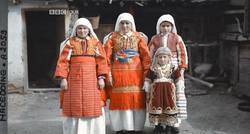In 1909, a wealthy French businessman named Albert Kahn set out to do something that had never been done before. He would create a photographic record of the entire earth. That was ambitious enough. But Kahn wanted this to be more realistic than anything that had ever been done.
Because he wanted the photographs to be in color.
 At the time, color photography was almost unheard of. But a rare and expensive form of it was just starting, called autochrome. Kahn had the money and resources to use it. So he sent photographers to every continent to take pictures using this technique, and over 20 years they collected 72-thousand images. Kahn called his project, “The Archives of the Planet.”
At the time, color photography was almost unheard of. But a rare and expensive form of it was just starting, called autochrome. Kahn had the money and resources to use it. So he sent photographers to every continent to take pictures using this technique, and over 20 years they collected 72-thousand images. Kahn called his project, “The Archives of the Planet.”
The BBC has now done a series about this project, and many of the photographs have been collected in a massive book. To see these pictures today is to witness history more vivid than most of us realize – because it is a time that looks very much like our own.
We tend to think of the early 1900s in black-and-white. But no. In Kahn’s collection, you see people from China wearing brilliant Technicolor silks. American cowboys with ruddy skin. A couple from Holland standing in wooden shoes, appearing as if in costume – until you realize, that’s what they wore every day in 1915. You see soldiers in battle fatigues from World War I. And there’s a startling shot of the Plaza Hotel, with Central Park stretching beyond, appearing as if it were taken just last week – if last week were 100 years ago.
Kahn’s undertaking forces us today to reconsider what we thought we knew – and to see with new eyes.
The world in those pictures is complex and colorful. It’s not all black-and-white. That can be quite a discovery.
As we hear in today’s reading from The Acts of the Apostles, the early disciples had a similar discovery.
The reading describes a meeting in Jerusalem in the first days of the church that had to decide if new Christians needed to be circumcised – if Gentiles needed to obey the strict rules of Jewish tradition. For some, it was a black-and-white issue. But others strongly disagreed – as Acts puts it, “there arose no little dissension and debate.” In the end, guided by the Holy Spirit, the decision was made to avoid placing any “burden” on new converts. They found a way to accommodate the Gentiles – and, in the process, opened up Christianity to a wider world. A world in living color.
Many of us, I suspect, are here today at least in part because of that momentous decision – a decision that allowed more people to easily become Christians, and to carry the faith to every corner of the globe.
As we just prayed in the responsorial psalm: “So may your way be known upon the earth, among all nations your salvation.”
And so it was. And so it is.
Look at the readings this Sunday, and you realize that something surprising and new is taking place. The miracle of the resurrection is continuing. A church is being born.
What began with Christ’s words to his disciples – “Do not let your hearts be troubled” – continued in the hearts of those gathered in Jerusalem. And it goes on even today.
It goes on here, and around the world, around countless altars where the great banquet of the Eucharist is celebrated, and the great work of the church is carried out, whether in schools or hospitals, whether in orphanages or offices, where the message is, again and again: “Do not let your hearts be troubled.”
There are many troubled hearts in the world right now – in Greece, in Times Square, on Wall Street. You’ll find many troubled hearts on the Gulf Coast, where this morning fishermen and their families are gathering to pray, amid fears that their livelihood and their way of life may be coming to an end.
What will they hear? Words of consolation, encouragement, hope. Words that were addressed long ago to another group of fishermen who were also facing an uncertain future.
“Do not let your hearts be troubled.”
Trust, too, in this knowledge: the miracle of the resurrection goes on.
It goes on wherever love conquers fear, wherever hope triumphs over despair.
It goes on among all those able to see the world with new eyes – the eyes of faith.
I know these are uneasy times – for our world, and for our Church. But remember Albert Kahn’s photographs. They show us a world remarkably like our own, in all its color and contrast and complexity. The same might be said of today’s scripture readings. The church of 2,000 years ago was — like the church of today — full of uncertainty and disagreement. But it was guided by the Holy Spirit. And so are we.
That is the good news of this particular Sunday. As the gospel reminds us, Christ left to his disciples something beyond this world: his peace. It’s the first word he spoke to his apostles after he rose – and one of the last he uttered before he left them. Peace. It sustained first century Jerusalem. And it will sustain us, too.
So: do not let your hearts be troubled.
Christ’s peace is with us.
And the miracle of the resurrection goes on.

